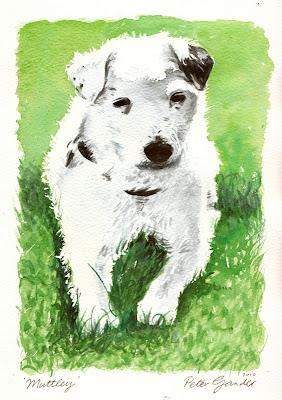 |
| Muttley © Peter Gander |
Tuesday, December 28, 2010
Muttley
Monday, December 27, 2010
Stanley, Bishopstone Beach, Kent
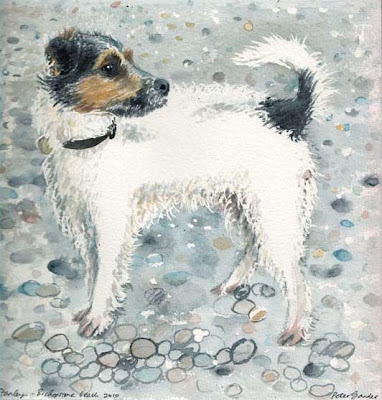 | ||
| Stanley, Bishopstone Beach, Kent © Peter Gander |
Thursday, December 09, 2010
Border Collie Bobby drawing
Friday, November 05, 2010
France: Pork joint and French beer
 |
| French beer & glass © Peter Gander |
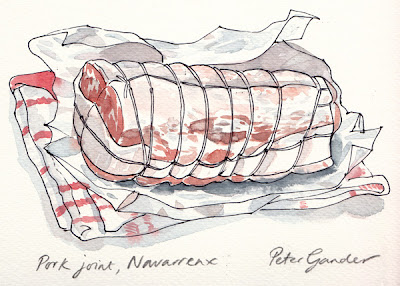 |
| Pork Joint, Navarrenx, France © Peter Gander |
Thursday, November 04, 2010
France, leek
France, Autumn marrow
Forgive me for I have not posted lately. Fiona and I returned to the south of France to Navarrenx where my brother lives, for his 50th birthday. Normally fishing would be high on the agenda, but sadly it was out of season. The local river Oloron is a salmon river and protected at this time of year so we couldn’t even fish for barbel or chub, not even tiddlers, (so I couldn’t live there, that’s not enough scope for fishing!) Thus I got out my filbert brush rather than my fishing rod and did some painting when we weren’t eating or sipping beers in the local bar.
It wasn’t terribly great weather for painting those lights and darks as it was grey and overcast all day as you can see from the overall tone of the painting with just a feint highlight on the marrow’s surface. It had been raining and this was painted in the rural garden of my brother’s gate house, The Concierge that he and his wife Lindy let out to holidaymakers. It lies about 20mins walk from their home in Navarrenx. I painted under a roof overhanging a patio area to the soft drip, drip of the rain falling off the leaves. A blackbird was rustling through fallen leaves in the garden, apart from that, it was wonderfully quiet. We later ate the marrow with Fiona’s roasted pork, the skin was as hard as nails to peel off but it tasted great.
 |
| Autumn marrow © Peter Gander |
Tuesday, October 19, 2010
Brown trout
 |
| Brown trout © Peter Gander |
Thursday, October 14, 2010
Portrait: Nikki
 |
| Nikki © Peter Gander |
Nikki at work has a very dramatic short and wavy hairstyle which motivated me to paint her. Her very dark hair is also a great contrast to her pale complexion. Painted from a reference pic taken back in the summer, the strong sun from a window added to the stark contrasts. In fact, I left the skin tone as the near-white of the Langton paper to emphasise and simplify things. Using the brush with a dryish mix of pigment for her hair lends a textural effect to the highlights, otherwise the hair becomes just a dark puddle of colour. Watercolour (Winsor & Newton) on Langton Prestige Mould-made 300gsm ‘Grain Torchon’ (rough) paper.
Wednesday, October 13, 2010
Old Man’s Head, British Museum
 |
| Old Man’s Head, (possibly the poet Hesiod), British Museum © Peter Gander |
Tuesday, October 12, 2010
The Mall Galleries
 | |
| The Mall Galleries © Peter Gander |
| The set-up for painting on the train © Peter Gander |
Friday, October 08, 2010
Tower Bridge from Cannon Street station
 |
| Tower Bridge from Cannon Street station © Peter Gander |
Thursday, October 07, 2010
Mermaid fountain, Trafalgar Square, London
 |
| Trafalgar Square Fountain © Peter Gander |
Friday, October 01, 2010
Pret delivery man
 | |
| 100101 Pret delivery man © Peter Gander |
Prets (Pret a Manger) Oxford Street, London, was my port of call for lunch today (Malaysian chicken soup was fabulous). Too wet outside today for ‘live’ sketching, so this is drawn from an old reference photo back at work in one of our teeny meeting rooms as the rain lashed the windows. Never traced of course, (that would be the sure death of the drawing), but stuck on a wall and drawn by eye, as if from life. That way a spontaneity is retained and the artist’s flair or character comes through in the style of drawing. Though it is really way too thin to take watercolour (at 160gsm), I used a pastel paper, Daler Rowney Murano (Neutral colours) Pastel Pad, as I liked the appropriate stony base colour for the stone-flagged streets of London. The white areas are Conté pencil and the key of the paper is visible in those areas. The Conté adds a lovely pastel-like chalkiness. Carbon pencil and watercolour on Daler-Rowney Murano Pastel Paper.
Sunday, September 26, 2010
Chimney pot seagull • SOLD
 |
| Chimney pot seagull • SOLD © Peter Gander |
Tuesday, September 21, 2010
Ship in a bottle, Trafalgar Square, London
 |
| Ship in a bottle, Trafalgar Square © Peter Gander |
Thursday, September 16, 2010
Red phone box, Piccadilly
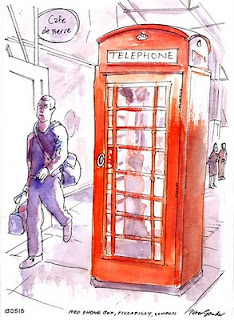 |
| Red phone box, Piccadilly © Peter Gander |
Monday, September 13, 2010
Spain, poolside sketches
 |
| Potted plant © Peter Gander |
 |
| Candy, the neighbour's dog. © Peter Gander |
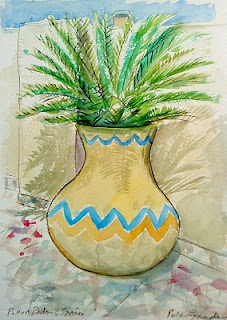 |
| Potted palm © Peter Gander |
Thursday, September 02, 2010
‘Rude Britannia’ Maggie Thatcher sketch
Fiona and I visited Tate Britain today in Pimlico, London for the final few days of the Rude Britannia (love that title) exhibition of comic British art. Comic as in humorous, this was not exclusively paper comic-based stuff, though there was plenty of that in the form of Viz characters. No, there were bawdy Victorian etchings to contemporary sculptures and everything in-between. Artsists included my own personal hero Donald McGill, who was perhaps the most skilful/least crude painter of the golden era of 1950s & 60s saucy seaside postcards (see top right in the image). In the political room, where patrons were encouraged to draw their own caricature, I went over to the Spitting Image figure of our former British Prime Minister (now Lady) Margaret Thatcher, the perhaps infamous Iron Lady who was a prime target of the satirical puppet series from 1984 and another decade after that. Of course, all I had to do was copy the already-caricatured profile - all the hard work had been done by Peter Fluck and Roger Law. Anyway, it was still a pleasure to do another in-situ sketch. If anyone’s in London until Sunday 5th September 2010, go and see it!
Tuesday, August 31, 2010
Street people (SOLD)
 |
| ‘Street People’ mixed media © Peter Gander • SOLD |
Thursday, August 26, 2010
Original painted postcards - seascapes
 |
| Low tide tracks © Peter Gander FOR SALE |
 |
| Early start © Peter Gander FOR SALE |
This one exploits the rough surface with a dryish brush. I use a huge size 20 squirrel mop, useful for overing a large area quickly.
 |
| Pebble path © Peter Gander FOR SALE |
Wednesday, August 25, 2010
Linocut sketch: Navarrenx salmon poster/postcard
 |
| © Peter Gander |
Tuesday, August 24, 2010
Piquillo
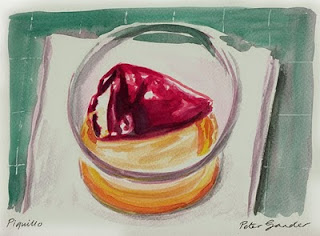 |
| A piquillo poses. © Peter Gander |
Friday, August 20, 2010
Mini linocuts, framed
 |
| © Peter Gander FOR SALE |
Thursday, August 19, 2010
Boat by The Street, Whitstable
 |
| © Peter Gander • SOLD (2010) |
Friday, August 13, 2010
'Local mackerel' linocut, the final print
 |
| © Peter Gander Limited Edition linocut FOR SALE |
'Local mackerel' linocut, inking to printing...
 |
| Using a heavy-duty craft (Stanley) knife to get rid of excess lino |
 |
| All off, then I bevelled the outer edge of the fish to avoid it catching any ink |
 |
| The complete rubbing. |
 |
| The fish is inked and awaiting a sheet of paper (and a printing felt over that) before the roller does its work. |
 |
| A ghostly fish is visible through the thin Japanese paper. Felt is laid over this to cushion the printing matrix. |
Thursday, August 12, 2010
'Local mackerel' linocut, final cut marks, work-in-progress...
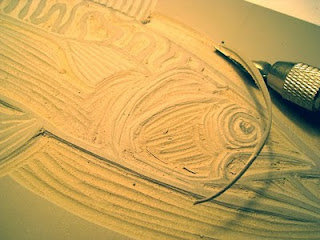 |
| © Peter Gander |
 |
| © Peter Gander |
Wednesday, August 11, 2010
'Local mackerel' linocut, first cut marks, work-in-progress...
I carve the lino initially in an outline first, to seperate the whole shape from the background (which will be cut off later and the carving laid out to register on a block). Different tools are used here for different purposes. Not that the finer 'V' tool is used to inscribe the fine ridges of the fish's pectoral fins and a wider 'U' tool ploughs out larger areas that will be white/blank, such as the belly area or outside the outline itself.
'Local mackerel' linocut, tracing down work-in-progress...
Having carefully copying the mackerel design onto tracing paper, it's ready to be flipped back-to-front and transferred onto the lino itself.
Subscribe to:
Posts (Atom)
Illustration for upcoming 'Lake District Map'
Hand-drawn in brush pen with digital colour. © Peter Gander

-
Crow II monoprint © Peter Gander Another monoprint study. This is essentially a sketch for a two-colour linocut that I plan to cut later ...
-
Using a heavy-duty craft (Stanley) knife to get rid of excess lino All off, then I bevelled the outer edge of the fish to avoid it catc...
















